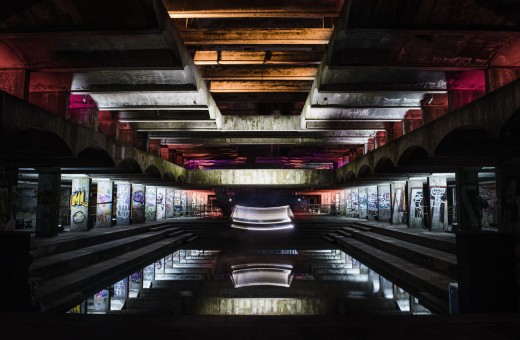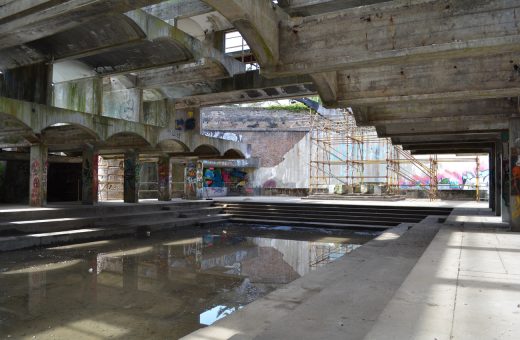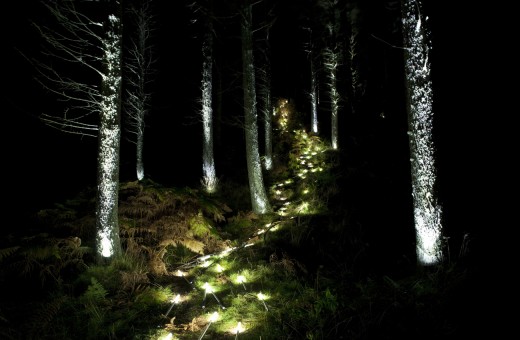July 2012: Safe As Houses – Group A3 Design, Rationale, & Reflection
23/07/2012
I was part of A3, a team of 4, who worked on the ground/crypt floor of St. Peter’s. After receiving our instructions/directions/safety announcement from Ed and Hayden, we spent a great deal of time exploring the floor and discussing what ‘safety’ means within this particular environment at this point in time. We perused the groundplan of the site, trying to make sense of it within the three-dimensional material conditions of the building. We determined that we would not only locate a position of relative safety for our tent, but that we would outline a ‘safe’ path that would, we hoped, direct/guide our imagined child in a way that would allow her/him to experience some fascinating aspects of this ground floor without being exposed to too many physical dangers.
The rationale for our tent placement and path (delineated by chalk, cones, and caution tape) included the following:
1) The tent was placed close to an exterior ‘wall’ so that in the event of falling debris, etc. the child could quickly escape the confines of St. Peter’s for the ‘safer’ surroundings of the Kilmahew grounds
2) The tent stood under what appeared to be a reinforced archway (as opposed to near the eroding staircase, etc.) in an area that received a lot of sunlight
3) We positioned the tent a few feet away from the very edge of the room, in order to protect the child from rain, mud, or debris that might slide down the sets of stairs that descended into the ground floor of the building
4) The tent’s main opening faced the interior of the room – we hoped this position would welcome and guide the child into the intriguing rooms and corridors of this floor
5) Caution tape and cones outlined a curving pathway that extended out from the tent and around the central stairway, across the room and then down one of the corridors. We generated this path to circumvent especially dangerous-looking debris (metal scraps, broken cement, holes in the floor, etc.) and weak spots in the ceiling
6) A chalk outline of the path accompanied the cones & tape – arrows suggested ways to move within the path. “No Entry” was written on the floor in a couple of places to identify very unsafe areas of broken glass or unstable flooring
Reflections on the project:
I felt challenged by the task and appreciated the tensions between serious assessment and playful collaboration. I suppose that tensions, contrasts, and juxtapositions were what I primarily felt/sensed/witnessed during our workshop. The brightly colored materials with which we worked reflected some of the shapes and colors visible in the graffiti/artwork that covers many of the walls, ceilings, and columns of St. Peter’s. The plastic and cloth materials made an intriguing visible and tangible counterpoint to the grey concrete that comprises much of the architectural structure.
In terms of St. Peter’s at large, even after seeing many photos of the building prior to visiting, I was still struck by the interplay of light and dark and those places (on floors, ceilings, etc.) where sunlight met shadow. Given the intense sunshine and warmth I experienced on our collective walk, I also felt attuned to how gentle breezes wafting in the seminary encountered dense building materials and dank corridors.
Post-workshop I have been reflecting on habitation. Who and what lives where? How? Why? For how long? Under what conditions, threats, opportunities? What are the different conceptualizations and experiences we have of ‘houses’ (whether they be safe or not)?
After our workshop day, I traveled through Argyll and over to Skye before making my way to Edinburgh (as I was re-visiting the UK for a month). I visited the Royal Botanic Garden in Edinburgh and saw a poetry & visual art exhibition called ‘Locating the Nest’ (created by H. Bryden, L. Farey, and T. Pow). Part of the exhibition was located in the Garden’s central indoor exhibition space and another part was scattered throughout the grounds. It got me thinking a lot about nests – their construction, purpose, inhabitants, location, duration, etc. They appear simultaneously fragile and durable. They can sometimes be re-used. Although one may not immediately associate a small, tenuously perched nest with the modernist design of St. Peter’s, I think there is something along that fragile-durable spectrum that has merged into my experience of the seminary. I look forward to reflecting more on the site and workshop, and to following developments of the Invisible College and its experiments until my next visit across the pond…
posted by Joanne Zerdy






